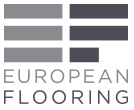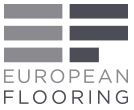With the popularity of herringbone hardwood floor and chevron hardwood floor steadily increasing over the last few years, there has been more interest in the details and history of these unique patterns. While both options are synonymous with trendy interior spaces, there are differences between the two flooring types, with each offering a distinct and dynamic design result.
If you are interested in adding pattern and dimension to your floors with something like herringbone hardwood floor, chances are that you have done a bit of research into pattern options. At European Flooring, we’re always ready to help our customers understand flooring trends and designs. Today, we’re sharing the key differences between herringbone and chevron flooring.

It All Comes Down To The Cut
With herringbone hardwood floor, the wood planks are cut about 2 feet in length, and staggered so that the end of one plank meets the side of another. To get a visual image, imagine a broken zig zag. The herringbone pattern has been around since the 16th century, but its sophisticated look still translates very well into modern commercial and residential properties.
A chevron pattern is created when wood planks are cut on an angle. When the planks are arranged, the result is a zig zag design created by connecting the straight line where the ends meet. The key identifier of a chevron floor pattern is a ‘V’ shape in the planks where two pieces connect to form a sharp point. Remember the road chevrons you see while driving? A chevron hardwood floor pattern mimics that shape to create dimension and a directional pattern. The design can make small or narrow rooms feel longer and create the illusion of more floor space.
When you look at pictures of both flooring patterns, the wood is arranged in a zig zag, but it’s the wood’s cut that will determine whether the herringbone or chevron design is laid.
Where Does It Fit Best?
There are many factors to think about when deciding whether a herringbone or a chevron pattern would work best. In the past, patterned floors were most often used in larger spaces. However, space is not a prerequisite and there is no question that each pattern adds interest and impact to any room.
In addition to the type and colour of hardwood, the chosen angle and width of the planks also give very different results. A wide herringbone pattern is more contemporary, while thin herringbone blocks can fit in well with urban, industrial, or vintage settings.
So, where does herringbone and chevron hardwood patterns fit best? The answer is – anywhere! It really comes down to your design preference and style choices. In order to help you determine the right option for your residential or commercial space, contact a hardwood floor expert who can answer all your questions and show you the options available for your project.
European Flooring’s Designer Showroom In Toronto
At European Flooring, we understand how important it is to choose the right hardwood flooring. That’s why we use large display panels in our showroom to provide you with a better understanding and appreciation of the appearance of each flooring choice. Contact us to book a showroom appointment. With 50+ surfaces and finish treatments for you to choose from, our flooring experts are ready to help you make the right selection.



